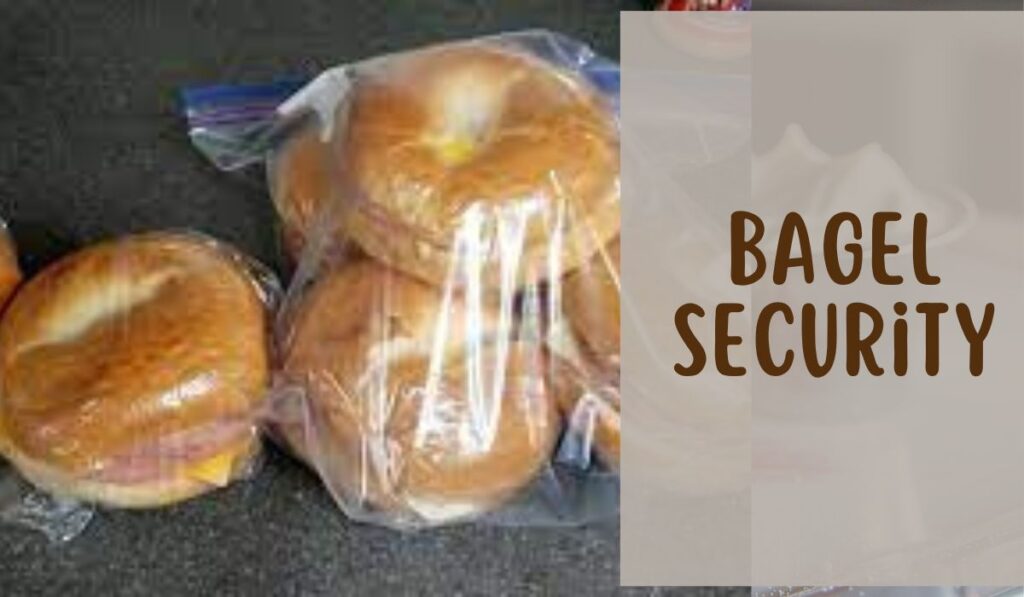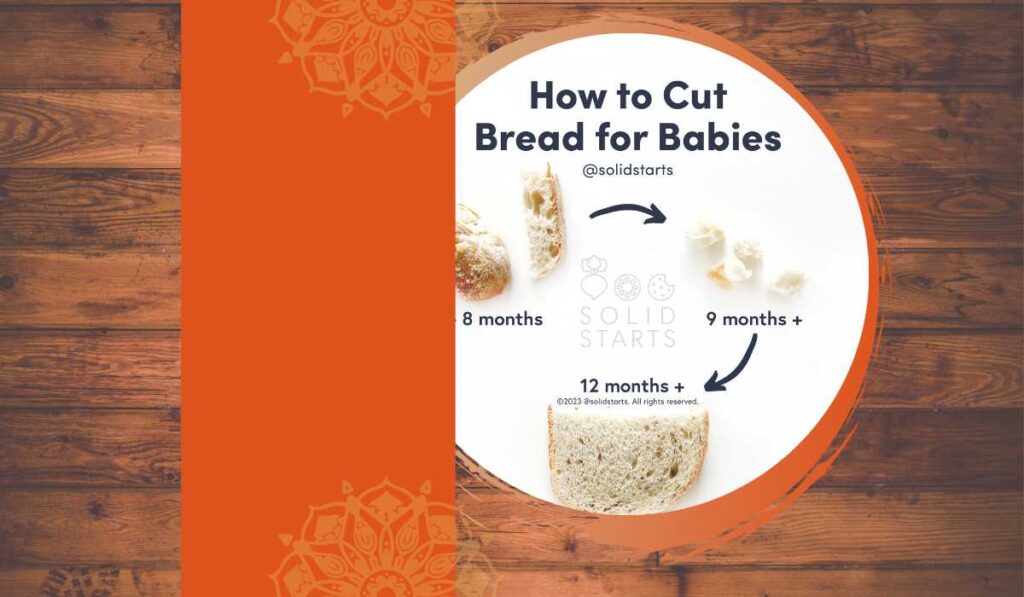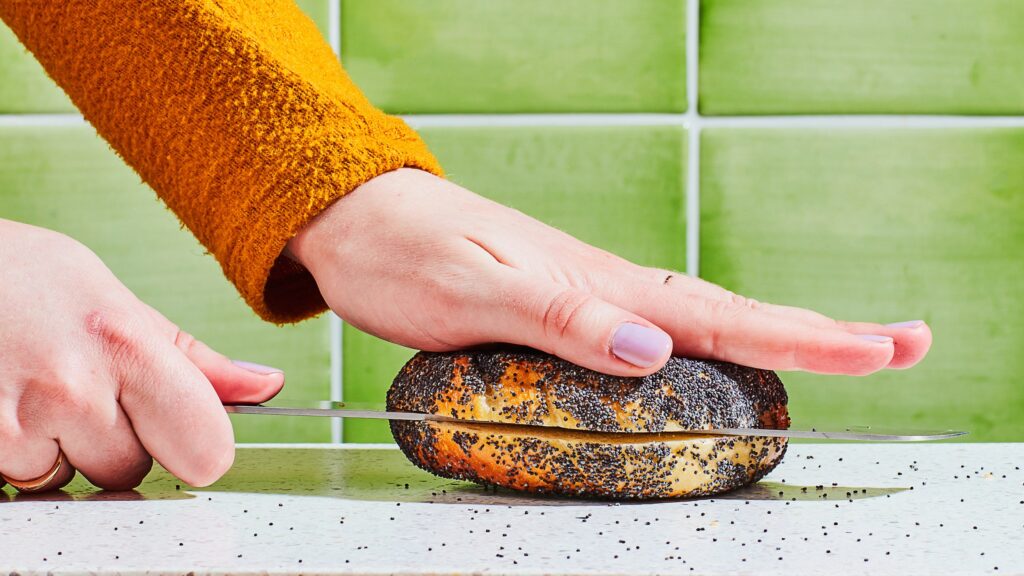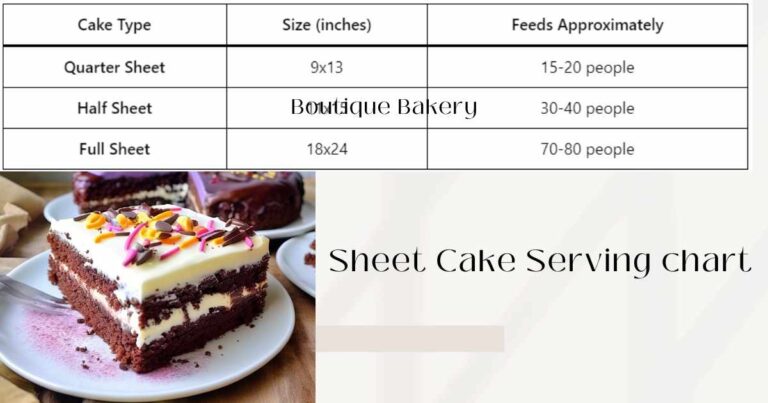To cut a bagel, first, stabilize it and then use a sharp knife to slice it horizontally. This technique ensures an even and clean cut.
Cutting a bagel properly is essential to enjoy it to the fullest. A bagel, a round bread roll with a dense chewy interior, is typically sliced horizontally to create two symmetrical halves. This allows for easy spreading of toppings or filling.
To achieve a perfect cut, start by holding the bagel securely in one hand, with your fingers away from the cutting edge. With a sharp knife, carefully slice through the center of the bagel in a smooth motion, applying gentle pressure. The resulting halves should be even and neat, ready to be toasted, filled, or enjoyed as desired.
Understanding The Bagel Anatomy

Bagels are a beloved breakfast staple that can be enjoyed in various ways. To master the art of cutting a bagel, it’s essential to understand its anatomy and identify the different parts that make up this delicious treat. By familiarizing yourself with the bagel’s crust, top, and bottom, you can ensure optimal results when cutting it.
Different Parts Of A Bagel: Crust, Top, And Bottom
When it comes to bagels, there are three key components to consider: the crust, top, and bottom. Understanding the characteristics of each part will help you navigate the cutting process with precision and finesse. Here’s a breakdown of these distinct elements:
- Crust:
- The crust of a bagel is the outermost layer that gives it its signature texture and appearance.
- It is slightly crispy and typically has a darker color compared to the soft interior.
- The crust is essential in providing a satisfying contrast of textures when biting into a bagel.
- Top:
- The top of a bagel refers to the rounded side that faces upward when it is served.
- This is the side where various toppings, such as seeds or spices, are often applied for added flavor and visual appeal.
- The top surface is usually smoother and more uniform in appearance compared to the bottom.
- Bottom:
- The bottom of a bagel is the flatter side that rests on the plate or any surface when served.
- It is the side where the bagel comes into contact with the baking or cooking surface, resulting in a slightly different texture than the top.
- While the bottom may appear less visually appealing, it still contributes to the overall taste and texture of the bagel.
Identifying these different parts of a bagel is crucial when determining where to make your cuts. By having a clear understanding of the bagel’s anatomy, you can make precise and intentional cuts to ensure the best experience for yourself and others.
Whether you prefer a classic horizontal cut or exploring creative alternatives, the knowledge of the bagel’s crust, top, and bottom will serve as your guide. So grab your favorite knife and get ready to slice into the perfect bagel!
Tools And Techniques For Cutting

When it comes to cutting a bagel, having the right tools and using the proper techniques can make all the difference. In this section, we’ll explore the various tools you can use and the traditional cutting methods that can help you achieve the perfect slice.
Choosing The Right Knife For The Job
To cut a bagel effectively, choosing the right knife is essential. Here are some knife options to consider:
- Bread knife: A serrated bread knife with a long, thin blade is ideal for cutting bagels. The serrated edge allows for easier slicing through the tough crust without squishing the soft interior.
- Utility knife: A smaller utility knife can also be used, especially if you prefer a smaller size for better control. Look for a knife with a sharp, non-serrated blade.
- Bagel guillotine: If you want a foolproof method, you can invest in a bagel guillotine. This tool has a built-in blade guide, ensuring consistency and even slices every time.
Remember to choose a knife that feels comfortable in your hand and offers good control for precise cuts.
Exploring Traditional Cutting Techniques
When it comes to cutting a bagel, there are a few traditional techniques you can try:
- Two-handed method: Hold the bagel securely with one hand and slice through it horizontally with your knife. This technique works well if you want two equal halves.
- One-handed method: Hold the bagel in one hand while using the other hand to carefully cut through it. This technique is great for cutting bagel halves of different sizes or when you have limited space.
- Bagel scoop method: Instead of cutting the bagel all the way through, use a bagel scoop to remove some of the dough from the center. This technique reduces carb intake while still allowing you to enjoy the bagel experience.
By experimenting with these techniques and finding the one that suits you best, you’ll be able to cut your bagels effortlessly and enjoy them exactly the way you like.
So, whether you prefer a classic bread knife or want to try out a bagel guillotine, selecting the right tool and practicing the proper cutting technique will ensure that you have perfectly sliced bagels every time.
Expert Tips For Perfect Slicing
Achieving Uniform Slices: Maintaining Consistency Throughout The Bagel
Have you ever struggled to cut a bagel evenly? You’re not alone! Achieving uniform slices can be quite a challenge, but fear not, as we have some expert tips to help you master the art of bagel cutting. By following these suggestions, you can ensure that each slice is consistent and visually appealing.
- Hold the bagel firmly: Make sure to grip the bagel securely and keep your fingers away from the cutting area.
- Use a ruler or guide: To achieve uniform thickness, consider using a ruler or a slicing guide to measure and mark the desired thickness for each slice.
- Steady hand movements: When slicing, maintain steady hand movements to avoid uneven cuts. Slow and deliberate motions will give you more control over the blade.
- Clean the knife between cuts: Wipe the knife clean after each slice to prevent any dough or toppings from sticking and affecting the subsequent cuts.
- Practice makes perfect: Cutting bagels takes practice, so don’t be discouraged if your first attempts are not ideal. With time and patience, you’ll improve your technique and consistently achieve uniform slices.
The Importance Of A Sharp Knife: Ensuring Clean And Easy Cuts
Having a sharp knife is crucial when it comes to cutting bagels. A dull knife can make the process difficult and result in messy, uneven slices. Here’s why you should prioritize using a sharp knife when cutting bagels:
- Clean cuts: A sharp knife effortlessly cuts through the bagel’s crust and interior, ensuring clean slices without tearing or crushing the dough.
- Reduced effort: With a sharp knife, you’ll exert less pressure, minimizing the risk of accidents and making the process much easier and safer.
- Consistency: A sharp knife allows for more precise control, helping you maintain consistency in the thickness of each slice.
- Aesthetically pleasing: Clean cuts enhance the visual appeal of the bagel, making it more appetizing and enjoyable.
To ensure your knife stays sharp, consider using honing steel or sending it for professional sharpening when needed. Remember, a sharp knife not only makes bagel cutting easier, but it also improves the overall slicing experience.
Breaking The Bagel Mold: Unique Cutting Methods For Variety
Are you looking to add some excitement to your bagel-cutting routine? There’s no need to stick to traditional slicing techniques when you can break the bagel mold and experiment with different cutting methods. Here are a few unique ways to jazz up your bagel slices:
- Bagel chips: For bite-sized snacks or crispy toppings, try cutting the bagel into thin, round slices or half-moons. Toast them in the oven until golden brown, and you’ll have delicious bagel chips.
- Bagel bites: Create miniature bagel bites by cutting the bagel into small rounds. These bite-sized treats are perfect for snacking or serving at parties.
- Bagel boats: Slice the bagel in half horizontally and scoop out some of the dough in the middle. Fill the hollowed-out sections with your favorite spreads or fillings, creating a delectable bagel boat.
- Bagel sandwiches: Cut the bagel horizontally into two halves and use them as bread slices to make your favorite sandwiches. Get creative with your fillings for a unique twist on a classic sandwich.
Go ahead and break the bagel-cutting rules! These unconventional slicing methods open up a world of possibilities and allow you to enjoy bagels in new and exciting ways. So, grab your knife, think outside the box, and let your culinary creativity shine.
Remember, perfecting the art of bagel cutting takes time and practice. With these expert tips, you’ll be well on your way to achieving uniform slices, using a sharp knife, and exploring innovative cutting techniques. Happy bagel slicing!
Crust-First Or Flat-First Approach
When it comes to cutting a bagel, there are two main approaches: the crust-first method and the flat-first method. Both methods have their own advantages and disadvantages. Let’s weigh the pros and cons of each to help you decide which approach suits you best.
Crust-First Approach:
- Easier to handle: Cutting the bagel crust first allows you to hold the bagel more comfortably and securely, reducing the risk of accidents.
- Preserve moisture: By cutting the crust first, you leave the inner part of the bagel intact, which helps retain its moisture and freshness.
- Enhances toppings: With the crust left untouched, you create a larger surface area for your favorite toppings, allowing for a more generous spread and an enhanced eating experience.
- Promotes even toasting: Since the crust is left intact, the bagel toasts more evenly, resulting in a satisfying texture and flavor.
Flat-First Approach:
- Easier to spread toppings: By cutting the bagel flat-first, you create two even halves that are ideal for spreading cream cheese, butter, or any other toppings of your choice.
- Consistent thickness: When you cut the bagel flat-first, you have better control over the thickness of each half, ensuring a uniform bite and minimizing any potential for toppling sandwich fillings.
- Easier to toast: With both flat sides exposed, toasting the bagel becomes more efficient as the heat can reach both surfaces simultaneously, resulting in a quicker and evenly toasted bagel.
- Convenient for sandwiches: The flat-first approach makes it easier to assemble bagel sandwiches by ensuring that the fillings are evenly distributed between two flat halves, making for a perfectly balanced bite.
Remember, the choice between the crust-first and flat-first approaches ultimately depends on your personal preference and the intended use of the bagel. Whether you prioritize easier handling, enhanced toppings, or consistent thickness, consider the pros and cons of each method to find the one that aligns with your bagel-cutting goals.
Making The Most Of Different Bagel Sizes

When it comes to enjoying a delicious bagel, its size can vary significantly. From mini bagels to extra-large ones, each size offers a unique eating experience. To make the most of your bagels, it’s essential to adjust your cutting technique based on their diameter.
Here are some tips on how to cut different-sized bagels:
Adjusting Your Cutting Technique Based On Bagel Diameter:
- Smaller bagels:
- When dealing with smaller bagels, it’s best to opt for a traditional horizontal cut. This allows you to create two even halves that are perfect for sandwich-style toppings or spreads.
- Another way to enjoy smaller bagels is by slicing them vertically into thin rounds. These mini bagel rounds are great for appetizers or as a fun addition to a bagel-themed snack platter.
- Regular-sized bagels:
- Regular-sized bagels are the most common and versatile ones. For these, you can stick to the classic horizontal cut to create two halves that are ideal for spreading cream cheese or assembling sandwiches.
- If you’re feeling adventurous, try a diagonal cut instead. This angled cut adds a unique touch to your bagel and provides more surface area for your favorite toppings.
- Extra-large bagels:
- Extra-large bagels require some extra attention when it comes to cutting. To avoid uneven halves, it’s best to use a serrated knife. Start by scoring the bagel with a gentle circular motion. Once you’ve marked the circumference, use a steady hand to cut through the center.
- For a twist on presentation, you can opt for the vertical cut. This method creates bagel wedges that are perfect for sharing or dipping into your favorite spreads and dips.
By adjusting your cutting technique based on the diameter of your bagels, you can elevate your bagel experience and make the most of each bite. Whether you enjoy them as traditional sandwiches, snackable rounds, or creatively sliced wedges, you’re sure to savor every delicious morsel.
So, the next time you find yourself faced with a bagel of any size, embrace the variety and get creative with your cuts.
Bagel Security: Stabilizing The Bagel

When it comes to cutting a bagel, safety should always be a top priority. Improper handling can increase the risk of injuries and accidents. By following these techniques to stabilize the bagel, you can minimize the chances of mishaps and enjoy your freshly sliced bagel with confidence.
Here’s how to ensure bagel security:
Techniques To Minimize The Risk Of Injuries While Slicing:
- Place the bagel on a stable surface: Ensure the bagel is positioned on a cutting board or a plate to provide stability during the slicing process. A firm base will prevent any unnecessary movement.
- Use a bagel holder or a fork: Insert a bagel holder or a fork into the top of the bagel to secure it in place. This will provide a solid grip and reduce the chances of your hand slipping while cutting.
- Apply even pressure: When holding the bagel, apply even pressure with your hand to keep it steady. Avoid exerting excessive force as it can lead to accidents or uneven cuts.
- Keep your fingers clear: Position your hand away from the cutting area and ensure your fingers are out of harm’s way. This way, you can minimize the risk of accidental cuts.
- Utilize a sharp knife: A sharp knife is essential for effortless slicing. It allows for a smooth cut, minimizing the need to apply excessive force. Ensure your knife is sharpened regularly for optimal cutting performance.
By implementing these bagel-stabilizing techniques, you can create a safe environment while slicing your bagel. Remember to prioritize both your safety and enjoyment of this delicious treat. Happy slicing!
Creative Slicing Techniques
Flagel, Bagel Chip, Or Bagel Bowl: Exciting Alternatives To Traditional Slicing
If you fancy something different from the traditional bagel, why not try these exciting slicing techniques? These alternative methods not only add a creative twist to your bagel experience but also offer new and versatile options for enjoying your favorite treat.
Here are some unique ways to slice your bagel:
- Flagel: A Flagel, also known as a flat bagel, is a flattened version of the traditional bagel. To make a flagel, simply press down gently on the top of the bagel before slicing it in half. This technique gives you a thinner and wider bagel, perfect for creating open-faced sandwiches or toasting.
- Bagel chip: Transform your bagel into a savory snack by turning it into a bagel chip. Thinly slice your bagel into round discs and then bake or toast them until they become crispy. Bagel chips can be seasoned with various herbs and spices to add extra flavor. Enjoy them on their own, or pair them with your favorite dips and spreads.
- Bagel bowl: Take your bagel to a whole new level by turning it into a bagel bowl. Slice off the top of the bagel and carefully remove the inner dough, creating a hollow space. Fill the bagel bowl with your desired fillings, such as cream cheese, smoked salmon, or avocado. This unique presentation adds a fun element to your meal and allows for endless customization.
Slicing your bagel creatively not only enhances its visual appeal but also brings exciting new textures and flavors to your taste buds. Give these alternative slicing techniques a try and elevate your bagel experience to new heights.
Slicing For Sandwiches: Tips For Creating Perfect Sandwich-Ready Slices
When it comes to making sandwiches with bagels, achieving evenly sliced pieces can be a bit challenging. However, with these helpful tips, you’ll be able to create the perfect slice for your sandwich:
- Sharp knife: Use a sharp knife to slice your bagel. A dull knife can easily tear the bread, resulting in uneven slices. A sharp knife ensures clean and even cuts.
- Stabilize the bagel: To prevent the bagel from moving while you slice it, firmly hold it with one hand and place the other hand on top of the knife. This provides stability and control, allowing for precise cuts.
- Vertical slicing: Instead of slicing the bagel horizontally, try slicing it vertically. This technique creates two flat halves, making it easier to layer your sandwich fillings evenly.
- Consistent thickness: Aim for consistent thickness when slicing your bagel. This ensures that each slice has the same texture and holds the fillings well.
- Chill the bagel: If you find that your bagel is too soft or difficult to slice, consider chilling it in the refrigerator for a short time. Cold bagels are firmer and easier to cut.
By following these simple slicing tips, you’ll have perfectly sliced bagel pieces that are ideal for creating delicious and visually appealing sandwiches. Whether you prefer classic fillings or are feeling more adventurous, these techniques will ensure that every bite is enjoyable.
Achieving Clean and Even Bagel Slices
Bagel slicing is an art, and achieving clean and even slices not only enhances the visual appeal of your bagels but also ensures a consistent texture and flavor in each bite. Let’s delve into the key aspects of this skill:
Use a Sharp Knife
One of the foundational elements of successful bagel slicing is the choice of the right knife. A serrated knife is your best friend here. The serrated edges of the blade grip the bagel’s crust while smoothly cutting through the softer interior. This results in cleaner, more precise cuts. To ensure top performance, it’s crucial to keep your knife in its best condition through regular maintenance. Sharpen it as needed, and maintain the serrations to prevent crushing or tearing the bagel.
Maintain Steady Hands
Maintaining steady hands during the cutting process is equally important. Start with a firm grip on the knife, but avoid squeezing too tightly, as this can lead to loss of control. Applying even pressure while cutting is the key to achieving uniform slices. A controlled, slow, and gentle sawing motion is the technique to master. This approach prevents the knife from slipping and ensures clean, even slices.
Locate the Center Point
Before making your first incision, take a moment to identify the thickest point on the bagel’s top. Typically, this is the center, and it’s where you should begin your cut. By starting here, you ensure that your slices will be even in thickness. After slicing through the top half, it’s advisable to rotate the bagel 180 degrees before cutting the bottom half. This simple step helps maintain symmetry in your slices, resulting in a more professional appearance.
Visualize Desired Thickness
To maintain consistency in your bagel slices, it’s helpful to have a clear mental picture of the desired thickness. Whether you prefer thin or thick slices, visualizing this before each cut can guide your hand and knife to produce uniform results. This visualization technique is particularly useful when you’re preparing bagels for recipes or sandwiches where slice thickness matters.
Consider Specialized Tools
If you’re a dedicated bagel enthusiast and want to take your slicing skills to the next level, consider investing in specialized tools like a bagel guillotine or a dedicated bagel slicer. These devices are designed for precision and ensure perfectly even slices every time. They’re particularly handy if you frequently enjoy bagels and want a quick and foolproof way to achieve consistent results.
To Toast or Not to Toast

When it comes to bagels, the decision of whether to toast or not can significantly influence your bagel-eating experience. Let’s explore the options and best practices for toasting bagel halves:
Discuss the Option of Toasting Bagel Halves
Toasting a bagel is a culinary choice that can enhance its texture and flavor. It’s important to recognize that toasting is not obligatory; it’s a matter of personal preference. Many bagel enthusiasts enjoy the contrast of a crisp, slightly browned exterior and a warm, soft interior that toasting provides. This process can also intensify the bagel’s flavor, making it a popular choice for those who enjoy a richer taste profile. However, for some, the natural chewiness and subtle sweetness of a untoasted bagel are perfect as is.
The decision to toast ultimately depends on your palate and the specific bagel you’re enjoying. For instance, denser bagel varieties like whole wheat or everything bagels often benefit from toasting, as it can help balance their density and bring out their flavors. On the other hand, lighter bagels like plain or sesame may not require toasting for a satisfying bite.
Explain How to Toast a Bagel Properly for the Best Results
For those who choose to toast their bagels, achieving the perfect toast requires a bit of finesse. Here’s how to toast a bagel properly for the best results:
- Slice Before Toasting: It’s generally best to slice your bagel before toasting. This ensures even toasting on both sides and prevents uneven browning.
- Select the Right Setting: If you’re using a toaster, select the desired toasting level based on your preference. Some prefer a light toasting, while others go for a darker, crispier finish. Experiment to find your ideal level.
- Bagel Setting: Many toasters come with a bagel setting, which toasts the cut side while gently warming the outer crust. This is ideal for traditional bagel halves.
- Oven or Toaster Oven: If you don’t have a toaster, you can achieve great results in the oven or toaster oven. Place the cut bagel halves face up on a baking sheet and toast at 350°F (175°C) for 3-5 minutes or until they reach your desired level of crispiness.
- Watch Closely: Keep a close eye on the toasting process to prevent over-browning or burning. Bagels can go from perfectly toasted to burnt quickly.
- Butter or Spread After Toasting: If you enjoy butter, cream cheese, or other spreads on your bagel, apply them after toasting while the bagel is still warm. The heat helps the spread melt and blend into the nooks and crannies of the bagel.
Serving Suggestions And Storage Tips
Pairing Sliced Bagels With Spreads And Toppings:
- Cream cheese: Spread a thick layer of creamy, tangy cream cheese on your toasted bagel halves for a classic and indulgent treat.
- Smoked salmon: Top your bagel with thinly sliced, savory smoked salmon for a luxurious and flavorful combination.
- Avocado: Mash ripe avocado onto your bagel and sprinkle with a pinch of salt and pepper for a creamy and nutritious option.
- Tomato and basil: Add slices of juicy, ripe tomato and fresh basil leaves to your bagel for a burst of freshness and color.
- Peanut butter and banana: For a sweet and hearty twist, spread creamy peanut butter on your bagel and top with sliced bananas.
- Egg and cheese: Create a satisfying breakfast by adding a fried egg and melted cheese to your bagel. This savory combination is sure to keep you energized throughout the day.
Properly Storing Leftover Bagel Halves For Future Use:
- Wrap each bagel half individually in plastic wrap to maintain freshness and prevent drying out.
- Place the wrapped bagel halves in an airtight container or sealable bag to further protect them from moisture and freezer burn.
- Label the container or bag with the date to keep track of how long the bagels have been stored.
- Store the bagel halves in the freezer for up to 3 months. When ready to enjoy, simply thaw them at room temperature or toast them for a crispy texture.
- Alternatively, you can store the bagel halves in the refrigerator for up to 3 days. Keep them in a sealed container or wrapped in plastic wrap to retain freshness.
- To revive slightly dried-out bagel halves, lightly toast them before serving. This will give them a delicious crunch and restore their texture.
How to cut a bagel in half ?
Tools you’ll need:
- Bagel
- A serrated knife (preferred)
- A cutting board
Steps:
- Gather your materials: Make sure you have all the necessary tools ready.
- Prepare the bagel: Place the bagel on the cutting board. If your bagel is whole and not pre-sliced, you’ll need to cut it yourself. If it’s pre-sliced, you can skip this step.
- Hold the bagel securely: It’s essential to hold the bagel securely with one hand to prevent it from rolling or moving while you’re cutting it. Place your hand flat on top of the bagel to hold it in place.
- Position the knife: Hold the knife in your other hand, with the blade facing downwards. Position the knife’s blade in the center of the bagel’s top, where you want to start your cut. The center is usually the thickest part of the bagel.
- Sawing motion: Using a gentle sawing motion, slowly and carefully cut through the bagel. Do not apply excessive force; a serrated knife should be sufficient to cut through the bagel without much effort. Continue sawing until you’ve cut through the top half of the bagel.
- Rotate the bagel: Once you’ve cut through the top half of the bagel, carefully rotate it 180 degrees so that you can cut through the bottom half.
- Repeat the sawing motion: Continue the gentle sawing motion to cut through the bottom half of the bagel. Take your time to ensure a clean and even cut.
- Separate the halves: Once you’ve cut through both halves of the bagel, carefully separate them by pulling them apart. They should easily come apart along the cut you made.
- Optional: Toast or serve: You can now toast the bagel halves if you prefer them toasted. Otherwise, you can serve them as they are or use them for your desired bagel sandwich or topping.
How to cut Bagel for baby?

Ingredients:
- A plain bagel
Tools:
- A serrated knife
- A cutting board
Steps:
- Choose a Fresh Bagel: Start with a fresh plain bagel. Avoid bagels with seeds or toppings, as these can pose a choking hazard for babies.
- Wash Your Hands: Before handling any food, make sure to wash your hands thoroughly to maintain hygiene.
- Prepare the Cutting Area: Place the cutting board on a stable surface, like a countertop or table. Ensure it doesn’t wobble to prevent accidents.
- Cut the Bagel in Half: Use a serrated knife to cut the bagel in half horizontally. Make sure the bagel is evenly sliced to create two equal halves. Hold the bagel firmly to prevent it from moving while cutting.
- Cut Each Half into Smaller Pieces: Take one of the bagel halves and cut it into smaller, bite-sized pieces. These pieces should be small enough to prevent choking hazards but large enough for the baby to hold and munch on comfortably. You can cut them into strips, cubes, or any shape that your baby can grasp easily.
- Supervise Your Baby: Never leave your baby unattended while they’re eating. Keep a close eye on them to ensure they are chewing and swallowing safely.
- Serve with Caution: Offer the bagel pieces to your baby one at a time. Watch for any signs of choking or discomfort. If your baby seems to struggle or gag, remove the food immediately.
- Monitor for Allergies: If this is the first time your baby is trying a bagel, be vigilant for any signs of food allergies. These may include rashes, hives, swelling, vomiting, or diarrhea. If you notice any adverse reactions, consult your pediatrician.
- Encourage Chewing: As your baby grows and develops teeth, encourage them to chew their food thoroughly. Chewing is an essential skill for safe eating and digestion.
- Introduce Cream Cheese or Spread (Optional): If you’d like to add some flavor to the bagel pieces, you can lightly spread a small amount of cream cheese or a baby-safe spread. Ensure that the spread is appropriate for your baby’s age and doesn’t contain any allergenic ingredients.
Frequently Asked Questions On How To Cut A Bagel?
Can You Cut A Bagel With A Knife?
Yes, a sharp knife is the most common tool used to cut a bagel. Place the bagel on a cutting surface and use a gentle sawing motion to cut through the middle. Be careful and make sure your fingers stay clear of the knife.
Should You Cut A Bagel Horizontally Or Vertically?
Traditionally, bagels are cut horizontally. This creates two equal halves and allows for easy spreading of cream cheese or other toppings. However, some people prefer to cut their bagels vertically, especially if they want thinner slices or a different presentation.
Can You Use A Bagel Cutter To Cut A Bagel?
Yes, a bagel cutter is designed specifically for cutting bagels. It usually has a round blade attached to handles, making it easier to slice through the bagel without squashing it. This is a great option for those who want a quick and effortless way to cut their bagels.
Is It Necessary To Toast A Bagel Before Cutting It?
No, it is not necessary to toast a bagel before cutting it. Toasting the bagel is a personal preference and can enhance the flavor and texture. However, whether you toast it before or after cutting it is entirely up to you and depends on your desired taste and texture.
Conclusion
Mastering the art of cutting a bagel is essential for both safety and getting the perfect slice. By following the proper techniques outlined in this blog post, you can ensure that your bagels are evenly sliced, reducing the risk of accidents and enhancing your overall dining experience.
Remember to use a high-quality serrated knife and exercise caution when applying pressure to avoid any mishaps. Whether you prefer a traditional horizontal slice or a trendy diagonal cut, these methods will allow you to enjoy your bagels in whichever way you desire.
With practice, you will become adept at achieving consistent results every time. So go ahead, grab your favorite bagel and put your newfound skills to the test. Happy slicing!







